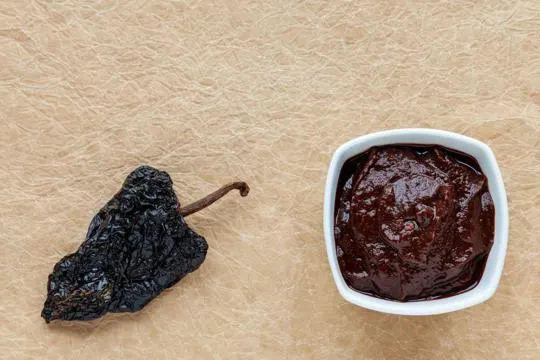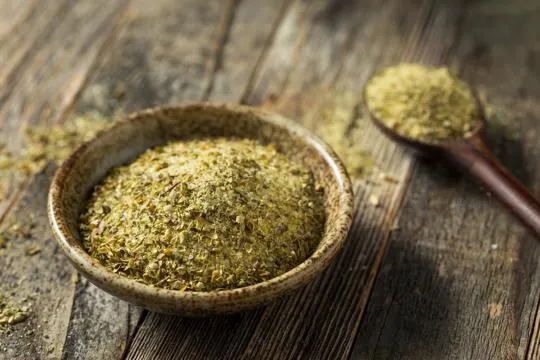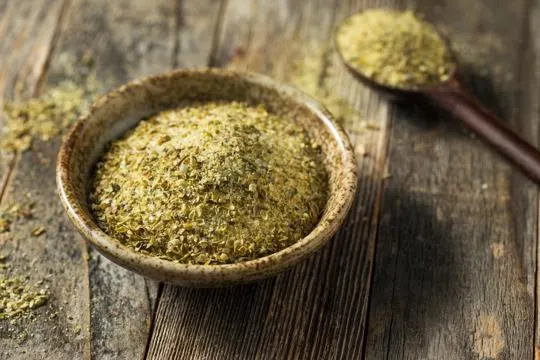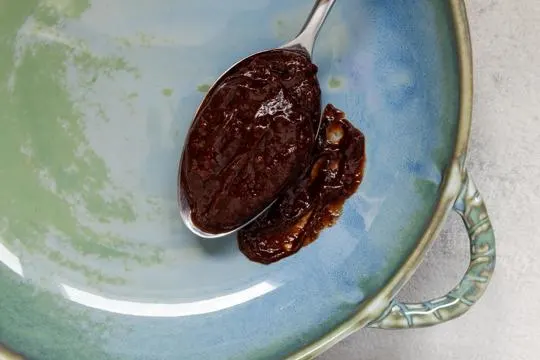Summary of key points
The main difference between adobo sauce and adobo seasoning lies in their consistency and primary ingredient. Adobo sauce is a liquid mixture often made with vinegar, soy sauce, and spices, while adobo seasoning is a dry blend of herbs and spices.
In terms of flavor, both offer a salty and tangy taste with notes of garlic and other seasonings. However, adobo sauce tends to be more concentrated and has a richer flavor compared to adobo seasoning.
In cooking, adobo sauce is commonly used as a marinade or sauce for meats, while adobo seasoning can be added to dishes during the cooking process for a burst of flavor.
Whether you’re looking for a liquid or dry option, adobo sauce and seasoning can add a delicious kick to your meals. Just be sure to check the ingredients as some brands may contain added sugars and preservatives.
Adobo sauce and adobo seasoning share a name, yet they dance to totally different beats.
First off, adobo sauce is a rich, smoky concoction. Think of it as the life of the party in many dishes.
Adobo seasoning, on the other hand, is the quiet cousin. It’s a dry mix that sneaks up with flavor.
We’ve all been there, mixing them up or scratching our heads at the grocery store.
The sauce is wet, the seasoning isn’t. That’s your quick tip.
In our kitchen adventures, we’ve laughed off many mix-ups. Mistook the seasoning for sauce once and ended up with a surprisingly crunchy taco.
Yep, we learn as we go, and today, we’re sharing those giggles and wisdoms with you.
Strap in for a fun breakdown. We’re decoding these twins – not really twins.
What is Adobo Sauce?

Adobo sauce is a classic ingredient in Filipino cuisine, made of vinegar, soy sauce, garlic, and spices.
Its rich and tangy taste adds depth to dishes.
It’s often used to marinate meats like chicken, pork, beef, or even fish.
It adds flavor and helps preserve the meat.
What makes adobo sauce special is its combination of ingredients.
Vinegar gives it a tangy flavor, soy sauce adds savoriness, garlic adds aroma and taste, and spices like bay leaves and pepper give complexity.
Adobo sauce is versatile – it can be used as a marinade or cooking sauce.
It can also be added to soups, stews, or stir-fries for an extra kick.
It complements various ingredients and cuisines.
What is Adobo Seasoning?

Adobo Seasoning – a blend of spices used in Latin American cuisine.
Common ingredients include garlic, oregano, pepper and salt.
This seasoning gives depth and complexity to dishes.
It can vary region to region or country to country.
For example, Puerto Rican Adobo spice may include annatto for colour and coriander for flavour.
Mexican Adobo may contain cinnamon and cloves for warmth.
Whether you make your own or buy one, experiment with different spice combinations to find the perfect balance of flavours.
Next time you want to add savoury goodness to your dishes, reach for some Adobo Seasoning and let your taste buds be delighted.
Differences Between Adobo Sauce and Adobo Seasoning

Adobo sauce and adobo seasoning may sound alike, but they have differences.
When selecting between adobo sauce and adobo seasoning, consider personal preference and recipe requirements.
Both provide unique flavors that can elevate dishes.
But it’s important to know how each ingredient affects the final dish taste and texture.
Ingredients Used
Adobo sauce and adobo seasoning are two important ingredients in many dishes.
Although they have the same name, there are differences.
The sauce is a savory, rich liquid with a blend of spices, vinegar, and sometimes soy sauce.
This sauce can be used as a marinade or cooking sauce.
Adobo seasoning is a dry blend of herbs and spices.
It includes garlic powder, onion powder, oregano, paprika, cumin, and black pepper.
This seasoning can be sprinkled onto food or mixed with other seasonings.
Adobo sauce has a tangy, acidic taste from the vinegar.
This helps tenderize meat and gives dishes a zing.
Also, it can be adjusted for desired spice level.
The seasoning is pre-mixed and ready to use.
It eliminates measuring individual spices to add a Filipino flavor.
In conclusion, adobo sauce and adobo seasoning are different yet contribute delicious flavors to recipes.
Personal preference and desired outcome will decide which to use. Both will elevate culinary prowess.
Preparation Method
Adobo sauce and adobo seasoning have different preparation methods. Let’s explore them.
Adobo sauce is a marinade made from chili peppers, vinegar, garlic, and spices.
It has a bold, tangy flavor and is popular in Mexican cuisine.
Adobo seasoning is a dry blend of spices like garlic powder, onion powder, black pepper, oregano, and paprika.
You can buy it pre-made or mix your own spices.
This seasoning adds savory flavor to dishes, without needing a liquid marinade.
Both adobo sauce and seasoning are versatile ingredients.
They can be used in marinades, soups, stews, and more.
In conclusion, adobo sauce is a marinade, while adobo seasoning is a blend of dry spices.
Try them out and add Mexican-inspired flavors to your cooking.
Texture and Consistency
Adobo sauce and seasoning have distinct textures.
The sauce is smooth and thick; it clings to ingredients, adding flavor and moisture.
The seasoning is dry, made of spices, herbs, and salt.
It adds flavor without changing the texture. Knowing the differences helps you choose.
The sauce coats; the seasoning adds flavor.
With this knowledge, you can make dishes with the texture you want.
You’ll get the flavor and consistency you desire.
Flavor and Culinary Use
Adobo sauce and adobo seasoning have different flavors and uses.
Adobo sauce adds a tangy, smoky taste to dishes like chicken or pork.
Meanwhile, adobo seasoning is a mix of spices like garlic, oregano, and pepper.
The sauce has a distinct taste. But the seasoning provides a versatile way to add flavor to various recipes.
Knowing these distinctions helps cooks pick the ideal ingredient.
Adobo sauce or adobo seasoning let chefs liven up their dishes with exciting flavors.
Similarities Between Adobo Sauce and Adobo Seasoning

Adobo sauce and adobo seasoning have similarities that make them a Filipino cuisine go-to.
They both bring out the flavor of various dishes, like meat and veggies.
They both contain garlic, black peppercorns, and bay leaves, giving them a distinctive savory taste.
The sauce and seasoning are both versatile ingredients.
Adobo sauce is usually marinated or used as a cooking sauce for meats, bringing out its tangy flavor.
Adobo seasoning is a blend of spices, sprinkled onto dishes or used to season meat before cooking.
Adobo sauce has an additional benefit of adding depth and complexity to dishes.
Its tangy and sweet taste can make grilled meats and roasted veggies taste better.
Adobo seasoning has a concentrated burst of savory flavors but doesn’t add any liquid.
Adobo seasoning is also convenient.
It’s ready-to-use, eliminating the need for preparation and measuring.
Adobo sauce requires some preparation time, as it needs to be mixed with other ingredients.
How to Use Adobo Sauce and Adobo Seasoning in Cooking
Adobo sauce and adobo seasoning are two special ingredients that give your cooking an extra kick.
Use adobo sauce by drizzling it over meats or mixing it into marinades.
Adobo seasoning is perfect as a dry rub or added to soups and stews.
Both these condiments have a balance of tanginess and smokiness.
Remember: a little adobo sauce goes a long way.
It has a strong flavor, so start with a small amount and gradually increase.
Use it in tacos, enchiladas, stir-fry and more.
Adobo seasoning typically contains garlic powder, onion powder, oregano, black pepper and salt.
It can be used to season meats before grilling or roasting.
Blend with other spices to make unique rubs or spice blends.
Experiment to find your favorite combinations.
Adobo sauce can also be used as a dipping sauce or condiment.
Try it with roasted vegetables, grilled tofu or nachos.
Some chefs even incorporate it into dressings and sauces.
With adobo sauce, the possibilities are endless.
Popular Dishes and Cuisines that Utilize Adobo Sauce and Adobo Seasoning
Adobo sauce and seasoning bring a unique flavor to many different dishes and cuisines.
From the Philippines to Mexico, these condiments add complexity to meals.
In Filipino cooking, adobo sauce is the go-to flavor enhancer.
Soy sauce, vinegar, garlic, and spices make up this savory marinade.
It tenderizes meat and gives it a tangy taste.
Adobo is often served with steamed rice.
In Mexican cuisine, adobo seasoning adds flavor to tacos and enchiladas.
The blend usually contains cumin, oregano, garlic powder, onion powder, and smoked paprika.
This mix goes well with meats and veggies. It creates smoky and spicy flavors.
Adobo sauce and seasoning can be used in many other ways.
They can be marinades, glazes, soups, stews, stir-fries, or salad dressings.
The possibilities are endless. Adobo sauce and seasoning bring great flavor to any dish.
Try them out to see how they transform your favorite meals.
Conclusion
In conclusion, it’s clear that there is a distinct difference between adobo sauce and adobo seasoning.
While both typically feature similar ingredients such as vinegar, garlic and oregano, the overall texture, flavor, and purpose of each dish is unique.
Adobo sauce is thicker in consistency and offers a salty-tangy taste while adobo seasoning has a more earthy flavor profile with mild saltiness due to the ground herbs and spices present in it.
What’s more, adobo sauce can be used as a marinade to flavor meats while adobo seasoning is mostly used for sautéing vegetables or flavoring stews.
Simply put, whichever product you choose to use all depends on what type of dish or flavor you’re looking to create.

Leave a comment